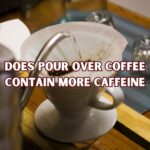Does pour over coffee contain more caffeine. As a coffee enthusiast, you may have heard that pour-over coffee is stronger and more caffeinated than other brewing methods like drip coffee or French press. But is this belief true? In this article, we’ll explore the factors that affect caffeine levels in coffee and compare the caffeine concentration in pour-over brewing to other popular methods.
By understanding the pour-over brewing process and the impact of variables like coffee bean origin, roast level, grind size, water temperature, and brew time, we can better comprehend how to manipulate caffeine levels in pour-over coffee. Additionally, we’ll debunk common myths surrounding pour-over coffee and provide tips for achieving consistent caffeine levels in your cup.
Understanding Caffeine Levels in Coffee

Before we compare the caffeine levels in pour-over coffee, it’s crucial to understand how caffeine is present and how it can vary depending on the brewing method used.
Caffeine is a natural stimulant in coffee beans, tea leaves, and cocoa beans. It is extracted from coffee beans during brewing and dissolved in hot water to create the energizing beverage millions consume daily.
Factors that affect caffeine levels in coffee include bean origin, roast level, grind size, water temperature, and brew time. The type of brewing method also plays a role in caffeine concentration.
When comparing pour-over brewing to other methods, such as drip coffee and French press, there is no significant difference in caffeine concentration, assuming all other variables remain constant.
However, the pour-over brewing method allows control over several variables affecting caffeine levels, such as grind size and pour rate. This control can result in a consistent caffeine concentration, making pour-over coffee an excellent option for those seeking reliable energy levels.
Despite this, the French press brew method has resulted in a slightly higher caffeine concentration than pour-over brewing. This difference is minor and mostly negligible, but it’s essential to note.
Combining Brewing Methods
It’s worth noting that some coffee enthusiasts combine brewing methods to create a unique flavor profile while manipulating caffeine levels. For example, a person could brew a strong coffee using a French press and pour it over ice to create an iced coffee.
| Brewing Method | Caffeine Concentration (mg/8 oz) |
| Pour Over | 96 |
| Drip Coffee | 95 |
| French Press | 107 |
Caffeine levels in coffee depend on several variables, and pour-over brewing is just one method of creating a delicious and energizing cup of coffee.
The Pour Over Brewing Process

The pour-over brewing process involves pouring hot water over coffee grounds, allowing the water to extract the flavor and aroma of the coffee into your cup. Unlike drip coffee, pour-over coffee is typically brewed by hand and has a more personal touch. Although it may seem simple, a few key factors influence caffeine levels in your pour-over coffee.
First, the grind size of your coffee beans plays a significant role in caffeine extraction. If your coffee is coarsely ground, it will take longer to extract caffeine, resulting in a weaker brew. Conversely, fine coffee grinds will extract caffeine faster and produce a stronger cup of coffee.
Secondly, the amount of coffee-to-water ratio affects caffeine concentration. A higher ratio of coffee to water will lead to a stronger brew that contains more caffeine.
Thirdly, water temperature is crucial for caffeine extraction during pour-over brewing. Ideally, use water between 195-205 °F (90-96 °C) to achieve the optimal caffeine content in your coffee.
Overall, pour-over coffee and drip coffee tend to have similar caffeine content, with pour-over coffee potentially having more caffeine due to the flexibility to adjust the grind size and ratio.
However, it also depends on the specific coffee beans used and the brewing method. It is also important to remember that caffeine is just one factor in the overall taste of your coffee, and the pour-over brewing method can provide a unique flavor profile that sets it apart from other methods.
Pour Over Coffee: A Stronger Brew?
Pour-over coffee is often associated with a bold and robust taste, leading to the belief that it contains more caffeine than other brewing methods. However, this is only sometimes the case.
Various factors determine coffee strength, including the amount of coffee grounds used, the grind size, and brew time. These factors can impact the coffee’s perceived strength but don’t necessarily affect the overall caffeine content.
There is no significant difference when comparing the caffeine levels in pour-over coffee to other brewing methods like drip coffee. Both methods can produce coffee with similar caffeine concentrations.
It’s worth noting that caffeine extraction is primarily influenced by the brewing process and the coffee bean characteristics rather than the strength of the coffee. Therefore, it’s essential to understand the variables that affect caffeine levels in pour-over coffee to control and optimize the final result.
Pour-over coffee is not inherently stronger in caffeine compared to other brewing methods. Its perceived strength is based on various factors, but the caffeine concentration can remain similar across different brewing processes.
Comparing Pour Over Coffee to Espresso

Pour-over coffee is often lauded for its bold and rich flavor, but how does it compare to espresso regarding caffeine concentration? While espresso is known for its high caffeine levels, it’s important to note that the serving size of espresso is much smaller than a typical pour-over coffee.
One shot of espresso, which is about 1.5 ounces or 42 milliliters, typically contains around 63 milligrams of caffeine. A standard 8-ounce cup of pour-over coffee can contain anywhere from 95 to 200 milligrams of caffeine, depending on various factors.
It’s worth noting that espresso’s caffeine extraction process differs from pour-over coffee. Espresso is made by forcing hot water through tightly packed, finely ground coffee, resulting in a strong, concentrated brew. Pour-over coffee, on the other hand, involves slowly pouring hot water over coarsely ground coffee, allowing for a more controlled and even extraction of caffeine.
So, while espresso may have a higher caffeine concentration per ounce, the overall caffeine content in a cup of pour-over coffee can be much higher due to its larger serving size. Additionally, pour-over coffee can offer a more nuanced and complex flavor profile compared to espresso’s intense and concentrated taste.
Factors Affecting Caffeine Levels in Pour-Over Coffee
When pouring over coffee, the caffeine content in your cup can vary depending on several factors. Here are some of the things that can affect caffeine levels in pour-over coffee:
| Factor | Description |
| Coffee Bean Origin | The type of coffee beans used is one of the primary factors influencing caffeine levels. Generally, Arabica beans have lower caffeine content compared to Robusta beans. |
| Roast Level | The darker the roast, the lower the caffeine content. This is because caffeine breaks down as the beans are roasted. |
| Grind Size | Finer grinds generally lead to higher caffeine extraction. The smaller the coffee particles, the more surface area is exposed to hot water, allowing for better caffeine extraction. |
| Water Temperature | Water temperature affects the rate of caffeine extraction. Higher temperatures result in faster extraction and increase the risk of over-extraction and bitterness. |
| Brew Time | Longer brew times can result in higher caffeine extraction and increase the risk of over-extraction. Shorter brew times may result in lower caffeine extraction. |
It’s essential to consider these factors when brewing pour-over coffee to achieve desired caffeine levels. Experimenting with these variables can help you fine-tune your pour-over technique, resulting in a cup with consistent and reliable caffeine content.
Debunking Myths about Pour Over Coffee and Caffeine
Several things could be improved surrounding pour-over coffee and its caffeine levels. One of the most common claims is that pour-over coffee has higher caffeine levels than other brewing methods, such as drip coffee. However, this is only sometimes true. The final caffeine content in your cup of pour-over coffee depends on multiple variables, including the type of coffee beans, roast level, grind size, and brewing technique.
Scientific studies have shown that drip and pour-over coffee can have similar caffeine levels. Some pour-over brewing methods extract less caffeine than drip coffee due to the longer brewing time.
It is also important to note that caffeine levels can vary greatly depending on the type of coffee beans used. For example, some coffee beans may naturally contain higher caffeine levels than others. Additionally, the roast level and grind size can impact caffeine extraction.
In conclusion, while pour-over coffee is a popular brewing method known for its robust flavor, it does not necessarily contain higher caffeine levels than other methods like drip coffee. The caffeine content in your cup of pour-over coffee depends on various factors, and understanding these variables can help you achieve the desired caffeine concentration in your brew.
Ensuring Consistency in Caffeine Levels
One of the challenges with brewing pour-over coffee is achieving consistent caffeine levels. The final caffeine content in your cup can vary depending on several factors, such as the coffee bean origin, roast level, grind size, water temperature, and brew time. However, you can use techniques and tips to ensure consistent results when making pour-over coffee.
Select the right coffee beans: The coffee beans you use can affect the caffeine content in your coffee. Generally, coffee from Robusta beans has higher caffeine levels than Arabica beans. However, Robusta beans can also result in a bitter taste. Therefore, selecting high-quality Arabica beans can provide a balance of flavor and caffeine concentration.
Measure coffee-to-water ratios accurately: The coffee-to-water ratio is another important factor in determining caffeine levels in your pour-over coffee. Usually, a ratio of 1:16 (1 gram of coffee to 16 grams of water) is recommended for pour-over coffee. However, adjusting the ratio can result in variations in caffeine levels.
Master the pour-over brewing process: Finally, to achieve consistent caffeine levels, it’s essential to master the pour-over brewing process. Ensure you pour the hot water slowly and evenly over the coffee grounds and maintain the correct water temperature. Also, timing your brewing process is crucial, as over-extraction or under-extraction can result in varying caffeine concentrations.
- Brewing Variable: Possible Impact on Caffeine Extraction
- Coffee Bean Origin: Different coffee bean varieties have varying caffeine levels.
- Roast Level: Dark roast coffee can have slightly less caffeine compared to light roast coffee.
- Grind Size :Finer grind sizes result in higher surface area and more extraction, potentially leading to higher caffeine concentrations.
- Water Temperature: Higher water temperature can lead to higher caffeine extraction but can also result in a burnt taste.
- Brew Time: Timing your brewing process is crucial, as over-extraction or under-extraction can result in varying caffeine concentrations.
By considering these factors and following the recommended techniques, you can enjoy a reliable and consistent caffeine level in your pour-over coffee. However, remember that the caffeine content will still vary depending on several factors, which may affect your coffee’s final taste and strength.
Unveiling the Truth: Pour Over Coffee and Caffeine Levels

Now that we have explored the different factors that impact caffeine levels in pour-over coffee, it’s clear that the final caffeine content in your cup depends on various variables. While the pour-over brewing process can influence caffeine extraction, it is not the determining factor.
The caffeine levels in pour-over coffee can vary greatly depending on various factors, including the type of beans used, roast level, grind size, water temperature, and brew time. As we discussed earlier, lighter roasts tend to have higher caffeine content, while finer grounds and hotter water can extract more caffeine.
It’s also important to note that pour-over coffee does not necessarily have higher caffeine levels compared to other brewing methods, such as drip coffee. While the pour-over process can produce a stronger flavor, it does not necessarily equate to a higher caffeine concentration.
Therefore, if you want to control the caffeine content in your pour-over coffee, paying close attention to these variables and experimenting with different brewing techniques to achieve your desired caffeine concentration is essential. You can create a delicious cup of coffee with reliable caffeine levels by mastering the pour-over process and using high-quality beans.
Ultimately, the key to enjoying a satisfying cup of coffee is to understand the factors that impact caffeine levels and experiment with different brewing methods to find your preference. With the right techniques and equipment, you can savor every sip of your favorite pour-over coffee tailored to your desired caffeine level.


